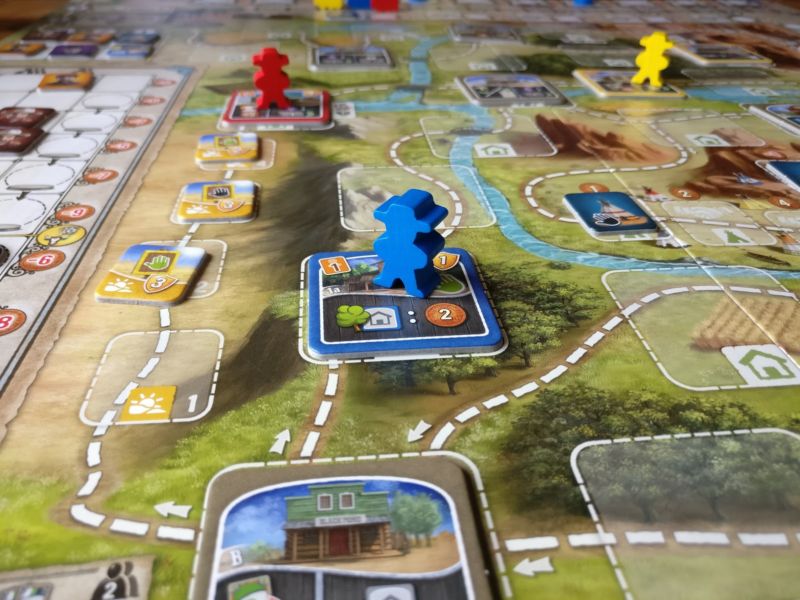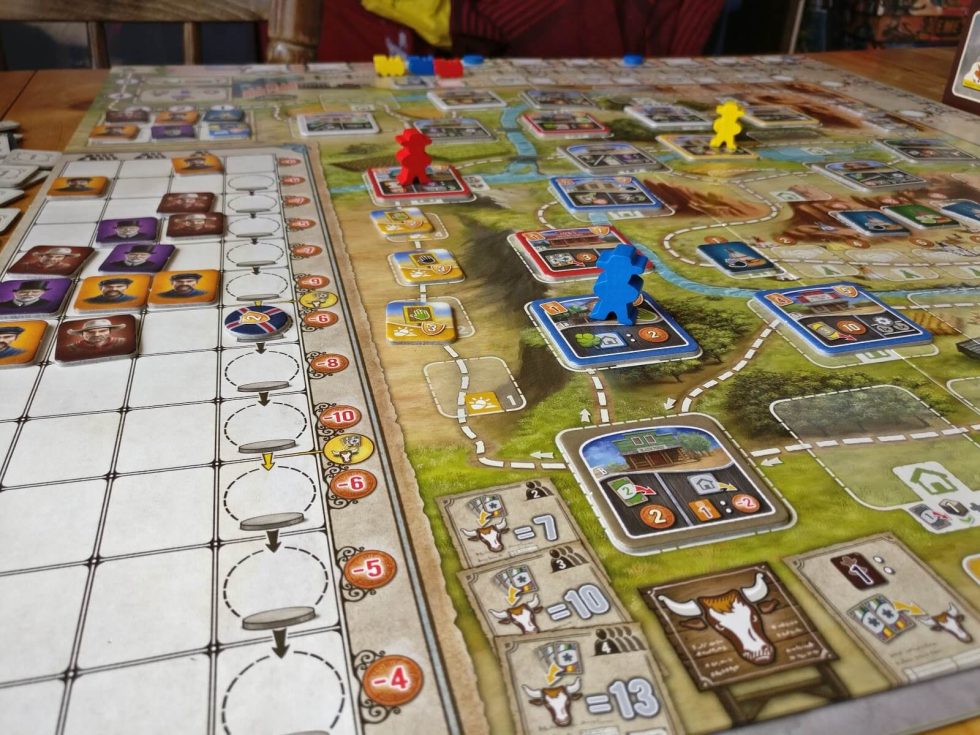
To some, the term “heavy Euro” might imply an especially minimal genre of EDM only heard at 6am on a Sunday morning in dank Berlin warehouses, but to board gamers, the term has different—if no less intense—connotations.
Euro games prize function over form, putting game mechanics above fluff and theme, but they can sometimes seem like competitive spreadsheeting in three dimensions, as players push wooden chips across patterned boards in order to maximize token yields. The heavier the Euro, the more loops and interlocking systems there are—and the more it can feel like you’re simulating MC Escher’s abacus.
But don’t let that put you off them.
-
These rough and tumble dudes are ready to rustle up some cattle.
-
The game's central board is big and colorful.
-
Build your deck of cow cards to sell when you make it to Kansas City.
-
Building tiles slot into spaces on the board; you can land on your own buildings to take special actions.
-
Each player gets 10, and they're double-sided to provide for variability.
-
Your player board stores your workers and tells you your current stats and abilities. Believe it or not, that collection of hieroglyphics at the top is meant as a helpful explainer.
-
You can remove these discs as the game goes on to get more powerful actions.
-
You don't have to work at CERN to parse the rulebook, but it helps.
-
End-game scoring bonus cards can be collected throughout the game to give you goals to shoot for.
-
Every time a player makes it to Kansas City, more workers are put out and made available for hiring. This display also serves as the game's timer.
-
An included scorepad details the many ways you can score points.
Great Western Trail, a quintessentially American game set in the Old West, designed by an Austrian and published by a German company, is a pretty heavy euro. At first glance (and, honestly, at any glance taken before you’ve sat through an hour of explainer videos), it’s a bewildering array of chips, counters, tiles, cards, and jaunty wooden cowboys. And while you might initially assume it’s a game of shootouts and train heists, it’s not. Great Western Trail is a game about driving herds of cattle across the Great Plains to Kansas City, whereupon you sell them and go back and start again.
It’s a simple idea, but it throws a whole heck of a lot of different concepts at you: you’ve got deck-building and hand management as you look after your handsome herd of cattle, tile placement and building management, point-to-point movement, and worker management—alongside all the clever ways such disparate mechanics are stitched together. The interplay between all these loops is where the magic is, but actually learning how to play the thing can be a high barrier to entry, a situation not at all helped by a manual that may as well have been written in forgotten elder runes.
Once you’ve cleared that barrier, though, Great Western Trail is an absolute delight. What starts out as a muddle of concepts all competing for your attention actually boils down to a delightful series of loops that interlock across a very simple, predictable trek from cow HQ at the bottom right of the board to Kansas City central station in the top left. You’ll have to make tons of decisions of all kinds during any given game, but because they never come at you all at once, something that is overwhelming at first sight becomes a genuine pleasure.
Git along, little dogies

It’s at these stops where much of the game happens; the trick, or one of the tricks, is to optimize your journey to Kansas City, enjoying the goods and services supplied along the way. Each player has a stack of ten buildings of their own (double-sided for variety), which they can plonk down to give them various benefits. On the way, one might encounter rockfalls or floods or Native American tribes, all of which cost money to pass. If you cross over certain tiles, you may even need to pay your opponents. And because players build new stuff as the game moves along, the whole experience starts out small and blossoms into meaningfully forking paths as more options are revealed.
Of course, it has its Euro ticks in abundance—there’s a lot of unlocking new abilities by moving cubes from one space to another—but it always feels intuitive. Its transit of wood is similar to but less intensive than in games like Scythe. In both games, players have their own personal mats to marshal, which are if anything even more busy to the untrained eye—a mess of covered action spaces, future transactions, and bafflingly arcane symbols that provide goodies as you go along. It’s on the mats that your growing staff of cowboys, builders, and engineers congregate; they’re recruited from buildings and help you buy cows (at buildings), build other buildings (at a building), and move your train along (in all sorts of ways, most of them building-related).Speaking of the trains, everyone has one. There’s a whole separate minigame everyone plays when they arrive at the city where they have to decide where they want their hairy children to end up. The farther you send them, the better the potential bonuses, but if your train is too far away because you didn’t use your time on the trail to get it moving, it’ll cost you money to send it there. There’s more to it than that, with the addition of station master tiles, five counters players can claim that give them permanent bonuses, and a couple of extra avenues to score. The track wends its way down the right-hand side of the board after San Francisco, allowing players who would rather be railwaymen than cattle herders to get extra points by, presumably, making their way to Ecuador.
Cleverly, every time you sell at a station, you get to move a token from your mat to the board. Each token on the board gives you points at the end of the game, bonuses if you claim adjacent cities farther away, or penalties if you take the easy route and sell to nearby towns. Under each token on your personal board is a new ability that might let you shunt your train a little further, or get rid of a hated Jersey forever, or increase your movement or your hand size. Everything is connected, and though the whole locomotive business is a mechanic that caused considerable additional confusion for new people in my playthroughs, once you get the gist of what the train aspect is actually for, it’s another layer of excellent intrigue.
Mashup master
Despite the way Alexander Pfister has endeavored to cram every last mechanic he’s ever heard of into his masterpiece, the game doesn't play as slowly as you might expect. Once people have the hang of it, which is usually halfway through their first game, things proceed at a disciplined pace (though your first game may be a long one as everyone gets their bearings). The marketplace of employees on the side of the board acts as a strict game clock, and even a four-player game shouldn’t last much longer than the 150-minute playing time suggested on the box, with surprisingly little space for analysis paralysis. If anything, the game ends a round or two before I'd like, which is usually an indication that a game has been properly balanced (there's always room to improve your efficiency!).
The game works just as well with three players, though there’s a little more space for buildings and less pressure on the cattle market. The two-player game is relatively brief and more cutthroat, but it still works just fine.
Great Western Trail has elements of a “point salad” game; there’s no scarcity of victory points, and players can choose to focus on several routes to victory, presenting another layer of significant choice.
Finally, it’s never openly mentioned that the cattle are being taken to Kansas for slaughter, so I like to pretend that Great Western Trail is a cow travel simulator, rather than an exercise in unstated carnage. When you get to the city, I can only assume you plonk them on trains and give them a great time seeing Sacramento, San Francisco, or Colorado Springs. It’s an all-around brilliant game, and I can’t recommend it enough for experienced board gamers who want a deep, mechanical experience and can spare a whole evening.
reader comments
18